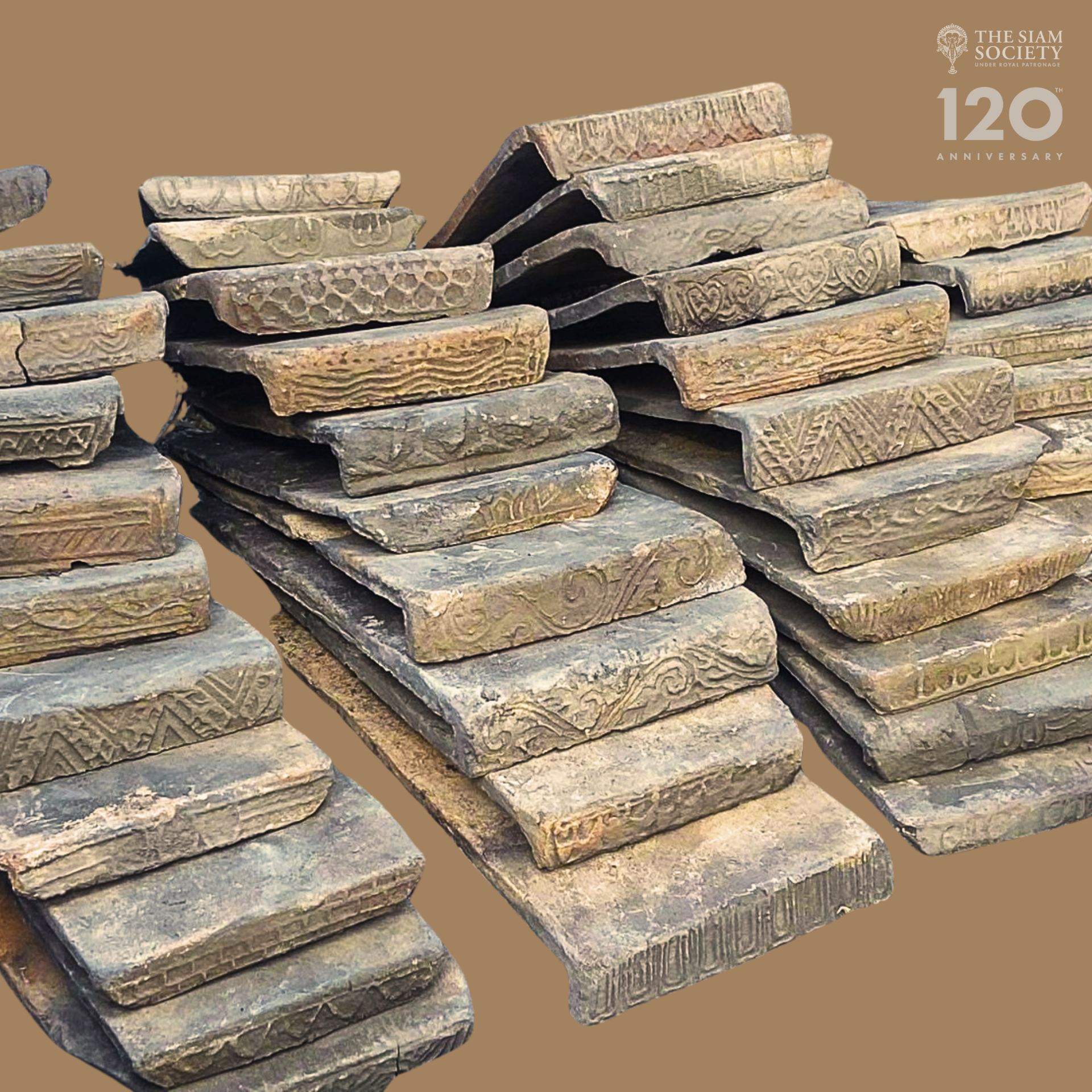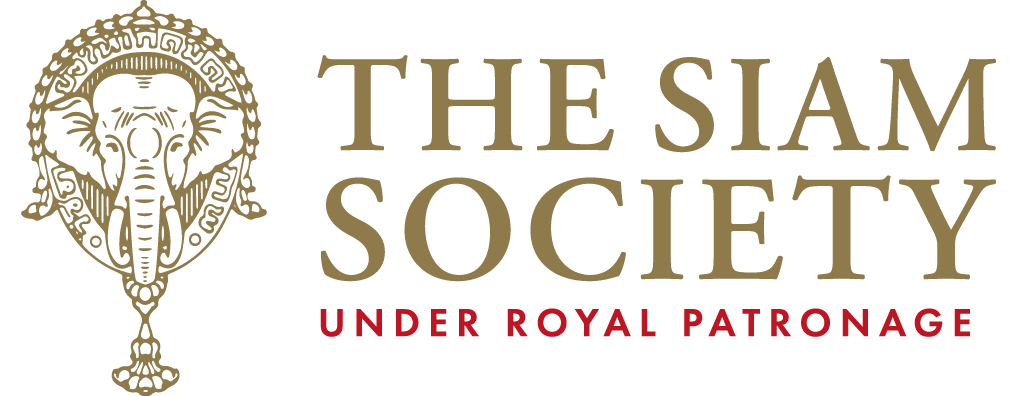
Lanna Clay Roof Tiles From Kamthieng House Museum
(สำหรับภาษาไทย กรุณาเลื่อนลงด้านล่าง)
When Kamthieng House was dismantled and transported to The Siam Society in 1965, Acharn Kraisri Nimmanahaeminda kindly provided 35,000 additional Lanna clay tiles made of clay or Din Kor (ดินขอ) for the restoration, collected from old houses and temples around Chiang Mai.
When The Siam Society carried out our major renovation of Kamthieng House this year, the team of artisans removed the roof tiles before the restoration and discovered century-old Din Kor tiles of various patterns of Din Kor tiles that had been forgotten. This has sparked a new interest in studying the Lanna cultural wisdom through these beautiful and durable tiles.
เมื่อมีการรื้อถอนตัวเรือนคำเที่ยง และขนย้ายมาปลูกใหม่ ณ สยามสมาคมฯ ในปี พ.ศ. 2508 อาจารย์ไกรศรี นิมมานเหมินท์ ได้กรุณามอบกระเบื้องดินขอล้านนาเพิ่มเติมมาอีกเป็นจำนวน 35,000 ชิ้น โดยรวบรวมจากบ้านเก่าและวัดทั่วเชียงใหม่ เพื่อให้ใช้ในการบูรณะหลังคาเรือนหลังนี้
ในปีนี้ ที่สยามสมาคมฯ กำลังทำการบูรณะเรือนคำเที่ยงครั้งใหญ่ ทีมงานซ่อมแซมได้รื้อกระเบื้องหลังคาออกก่อนการบูรณะ และได้พบกระเบื้องดินขอโบราณอายุราวร้อยปีเหล่านี้ ซึ่งมีลวดลายหลากหลาย กระเบื้องโบราณที่เกือบถูกลืมเหล่านี้ที่ยังอยู่ในสภาพสวยงามคงทน ช่วยจุดประการความสนใจใหม่ ในการศึกษามรดกภูมิปัญญาของล้านนา

Din Kor tile is a Lanna clay tile for roofing which can be found both with and without patterns. It can be used to roof religious buildings, traditional houses, and palaces. Craftsmen use clay to shape the tiles and fire them in a high-temperature kiln for several days to make them able to withstand exposure to the sun and rain. (Information from Lanna Traditional House Museum)
กระเบื้องดินขอเป็นกระเบื้องดินเผาล้านนาสำหรับมุงหลังคา สามารถพบได้ทั้งแบบที่มีและไม่มีลวดลาย อาจใช้มุงหลังคาของศาสนสถาน บ้านเรือน วัง ช่างใช้ดินเหนียวมาขึ้นรูป เผาในเตาความร้อนสูงนานหลายวัน เพื่อความทนทานต่อแสงแดดและฝน (ข้อมูลจากพิพิธภัณฑ์เรือนโบราณล้านนา มหาวิทยาลัยเชียงใหม่)

Din Kor tile is a Lanna clay tile for roofing which can be found both with and without patterns. It can be used to roof religious buildings, traditional houses, and palaces. Craftsmen use clay to shape the tiles and fire them in a high-temperature kiln for several days to make them able to withstand exposure to the sun and rain. (Information from Lanna Traditional House Museum)
กระเบื้องดินขอเป็นกระเบื้องดินเผาล้านนาสำหรับมุงหลังคา สามารถพบได้ทั้งแบบที่มีและไม่มีลวดลาย อาจใช้มุงหลังคาของศาสนสถาน บ้านเรือน วัง ช่างใช้ดินเหนียวมาขึ้นรูป เผาในเตาความร้อนสูงนานหลายวัน เพื่อความทนทานต่อแสงแดดและฝน (ข้อมูลจากพิพิธภัณฑ์เรือนโบราณล้านนา มหาวิทยาลัยเชียงใหม่)

The tiles are light and thin, which can give a natural feeling. They are also breathable which is an important aspect in Thai architecture that emphasises the design of the roof more than the wall. (Information from Lanna Traditional House Museum)
กระเบื้องมีความเบา บาง ให้ความรู้สึกเป็นธรรมชาติ อีกทั้งยังระบายอากาศได้ดี ปัจจัยนี้เป็นข้อสำคัญในสถาปัตยกรรมไทยที่ให้ความสำคัญกับการอออกแบบหลังคามากกว่าผนัง (ข้อมูลจากพิพิธภัณฑ์เรือนโบราณล้านนา มหาวิทยาลัยเชียงใหม่)

Din Kor tiles at Kamthieng House have the traditional Lanna patterns. Some were from old Lanna houses and temples in Chiang Mai and some were original tiles moved together with the house. This tile set can be classified into more than 20 pattern groups from 35,000 tiles. It is assumed that each group has different patterns due to the period and identity of each craftsman family. (Information from Mr Watanyoo Thephuttee)
กระเบื้องดินขอโบราณที่มากับเรือนคำเที่ยงมีลวดลายตามแบบล้านนาดั้งเดิม เป็นกระเบื้องเก่าที่มาจากเรือนและวัดเก่าในเชียงใหม่ ผสมปนกันกับกระเบื้องบางส่วนที่เป็นกระเบื้องเดิมของเรือน กระเบื้องชุดนี้ จำนวนประมาณ 35,000 แผ่น สามารถจำแนกความแตกต่างของลวดลาย ได้มากกว่า 20 กลุ่ม สันนิษฐานว่าลวดลายที่แตกต่างกัน อาจมาจากความต่างๆขอวช่วงเวลาที่ผลิตและอัตลักษณ์การออกแบบที่แตกต่างกันของช่างแต่ละตระกูล (ข้อมูลจากคุณวทัญญู เทพหัตถี)

You can also contribute to this restoration project by donating to “THE SIAM SOCIETY” TMBThanachart Bank (ttb), Asoke Branch, Savings Account No. 053-2-03946-8 or scanning the QR code in the last picture. Please kindly send us a copy of the transfer slip for us to issue an acknowledgement of your donations.
ท่านสามารถร่วมสมทบทุนในการบูรณะเรือนคำเที่ยงได้ โดยบริจาคเงินผ่านบัญชีสยามสมาคมฯ ธนาคาร ทหารไทยธนชาต (ttb) บัญชีออมทรัพย์เลขที่ 053-2-03946-8 หรือแสกน QR code ในภาพสุดท้าย พร้อมส่งหลักฐานการโอนเงินมาให้ทางสมาคมฯ เพื่อออกจดหมายขอบคุณให้กับท่าน
